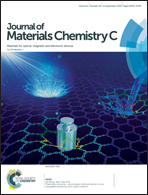Complex morphotropic domain structure and ferroelectric properties in high-TC single crystals of a ternary perovskite solid solution
Abstract
Ferroelectric and piezoelectric materials with a high Curie temperature (TC) have attracted increasing interest due to their requirement in applications under extreme conditions. In this work, novel high-TC ferroelectric single crystals of (0.95 − x)BiScO3–0.05Pb(Cd1/3Nb2/3)O3–xPbTiO3 (BS–PCN–xPT) ternary solid solution with various compositions have been successfully grown. With increasing PT concentration, a composition-induced structural crossover from a rhombohedral phase, through a morphotropic phase boundary (MPB), to a tetragonal phase, is observed. A monoclinic phase (space group Pm) is found at the MPB region. The temperature dependences of the dielectric permittivity reveal high Curie-temperatures of 363–452 °C (at 1 MHz). The macroscopic and mesoscopic ferroelastic/ferroelectric domain structures systemically characterized by polarized light microscopy (PLM) and piezoresponse force microscopy (PFM) reveal the existence of monoclinic domains in the crystals with the MPB composition. In the monoclinic crystals, the remnant polarization (33.2 μC cm−2) is weaker than that in the rhombohedral phase. All compositions studied show a high coercive field (around EC = 40 kV cm−1). The presence of a high TC and a stable poled state signifies that the BS–PCN–xPT single crystals are promising candidates for applications such as electromechanical transducers that can be operated in a wide range of conditions.



 Please wait while we load your content...
Please wait while we load your content...